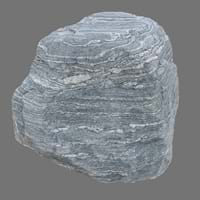Definition
Migmatite is typically a granitic rock within a metamorphic host rock which is composed of two intermingled but distinguishable components
Phyllite is a fine-grained metamorphic rock with a well-developed laminar structure, and is intermediate between slate and schist rocks
Origin
Southern Alps, France
Unknown
Discoverer
Jakob Sederholm
Unknown
Etymology
From the Greek word migma which means a mixture
From Greek phullon leaf + -ite1
Class
Metamorphic Rocks
Metamorphic Rocks
Sub-Class
Durable Rock, Medium Hardness Rock
Durable Rock, Soft Rock
Group
Not Applicable
Not Applicable
Other Categories
Coarse Grained Rock, Fine Grained Rock, Medium Grained Rock, Opaque Rock
Coarse Grained Rock, Fine Grained Rock, Medium Grained Rock, Opaque Rock
Texture
Foliated
Phyllitic Sheen, Slaty
Color
Black, Bluish - Grey, Brown, Brown- Black, Dark Greenish - Grey, Dark Grey to Black
Black to Grey, Light Greenish Grey
Durability
Durable
Durable
Appearance
Dull, Banded and Foilated
Crinkled or Wavy
Interior Uses
Countertops, Flooring, Kitchens
Decorative Aggregates, Floor Tiles, Homes, Interior Decoration
Exterior Uses
As Building Stone, As Facing Stone
As Building Stone, As Facing Stone, Garden Decoration
Other Architectural Uses
Curbing
Curbing
Construction Industry
As Dimension Stone, Cement Manufacture, for Road Aggregate, Making natural cement
As Dimension Stone, Building houses or walls, Cement Manufacture, Construction Aggregate, for Road Aggregate, Raw material for the manufacture of mortar, Roadstone
Medical Industry
Not Yet Used
Not Yet Used
Antiquity Uses
Artifacts
Artifacts, Sculpture
Commercial Uses
Cemetery Markers, Jewelry, Tombstones, Used to manufracture paperweights and bookends
Cemetery Markers, Commemorative Tablets, Creating Artwork, Writing Slates
Types
Diatexites and Metatexites
Not Available
Features
Generally rough to touch, Is one of the oldest rock
Easily splits into thin plates, Is one of the oldest rock, Surfaces are often shiny
Archaeological Significance
Monuments
Not Yet Used
Not Yet Used
Famous Monuments
Not Applicable
Not Applicable
Sculpture
Not Yet Used
Used
Famous Sculptures
Not Applicable
Data Not Available
Figurines
Not Yet Used
Used
Formation
Migmatites form by high temperature regional and thermal metamorphism of protolith rocks where rocks melt partially due to high temperature.
Phyllite is a metamorphic rock which is formed by regional metamorphism of argillaceous sediments since their cleavage arose due to deviatoric stress.
Mineral Content
Biotite, Chlorite, Feldspar, Garnet, Graphite, Hornblade, Micas, Muscovite or Illite, Quartz, Quartzite, Silica, Zircon
Albite, Alusite, Amphibole, Apatite, Biotite, Chlorite, Epidote, Feldspar, Garnet, Graphite, Hornblade, Kyanite, Micas, Muscovite or Illite, Porphyroblasts, Quartz, Sillimanite, Staurolite, Talc, Zircon
Compound Content
Aluminium Oxide, NaCl, CaO, Carbon Dioxide, Iron(III) Oxide, FeO, Potassium Oxide, Magnesium Carbonate, MgO, MnO, Phosphorus Pentoxide, Silicon Dioxide, Titanium Dioxide
CaO, Carbon Dioxide, MgO
Types of Metamorphism
Burial Metamorphism, Cataclastic Metamorphism, Regional Metamorphism
Not Applicable
Types of Weathering
Biological Weathering, Chemical Weathering, Mechanical Weathering
Biological Weathering, Chemical Weathering, Mechanical Weathering
Types of Erosion
Chemical Erosion, Glacier Erosion, Water Erosion, Wind Erosion
Chemical Erosion, Coastal Erosion, Glacier Erosion, Water Erosion, Wind Erosion
Grain Size
Medium to Fine Coarse Grained
Medium to Fine Coarse Grained
Fracture
Irregular
Conchoidal
Porosity
Very Less Porous
Highly Porous
Luster
Dull to Pearly to Subvitreous
Phyllitic
Cleavage
Poor
Crenulation and Pervasive
Specific Gravity
2.65-2.75
2.72-2.73
Transparency
Opaque
Opaque
Density
Not Available
2.18-3.3 g/cm3
Resistance
Heat Resistant, Pressure Resistant
Heat Resistant, Pressure Resistant, Water Resistant
Deposits in Eastern Continents
Asia
China, India, Iran, Iraq, Kazakhstan, Kyrgyzstan, Mongolia, Russia
Afghanistan, Bangladesh, Bhutan, China, India, Japan, Kazakhstan, Malaysia, Pakistan, Russia, Thailand, Turkey, Vietnam
Africa
Cameroon, Ethiopia, Ghana, Kenya, Madagascar, Morocco, Mozambique, Namibia, Nigeria, Tanzania, Togo
Egypt, Ethiopia, Morocco, Nigeria, South Africa
Europe
Albania, Austria, Bosnia and Herzegovina, Finland, France, Georgia, Germany, Hungary, Italy, Kosovo, Monaco, Norway, Poland, Romania, Serbia, Slovakia, Slovenia, Sweden, Switzerland, Ukraine, United Kingdom
Austria, England, France, Georgia, Germany, Italy, Liechtenstein, Monaco, Norway, Slovenia, Spain, Sweden, Switzerland
Others
Not Yet Found
Not Yet Found
Deposits in Western Continents
North America
Canada, Costa Rica, Cuba, Mexico, Panama, USA
Canada, Costa Rica, Cuba, Mexico, Panama, USA
South America
Argentina, Bolivia, Brazil, Chile, Colombia, Ecuador, Peru, Venezuela
Brazil, Colombia, Guyana
Deposits in Oceania Continent
Australia
New South Wales, New Zealand, Queensland, Victoria
New South Wales, New Zealand, Queensland










